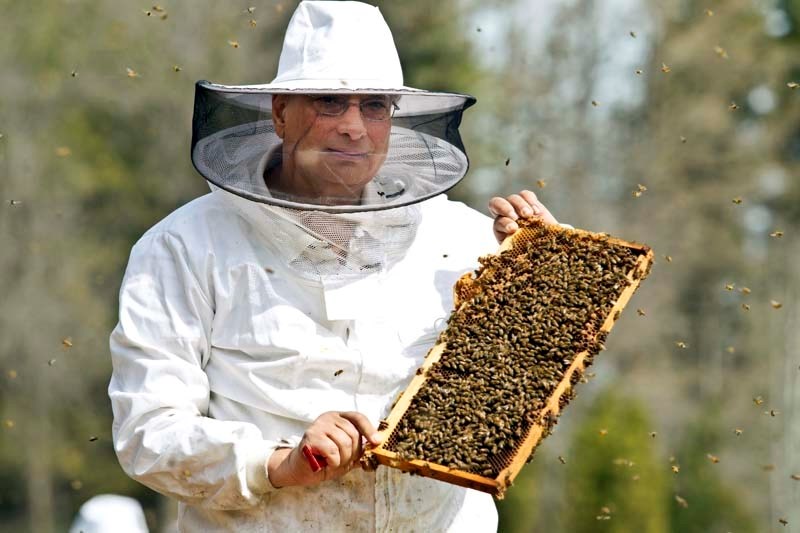Medhat Nasr is allergic to bees.
He is also the provincial government's top bee scientist.
You'd think this might be a problem for him, but it's not.
The allergy is to bee hair and not bee stings, explains the St. Albert resident, and he manages it with antihistamine.
"For the last 20 years, I haven't had any episodes about it."
And he hasn't had any problem with the zillions of bee stings he's received over the years – 200 of which came from one visit to a hive in the state of New York.
"Apparently the colony at that time was quite aggressive," he explains.
"I didn't get mad at the bees because I knew I was not supposed to be there at that time to bother them."
Nasr, 60, is the provincial apiculturist for Alberta Agriculture and a leading voice in Canada's bee research community.
He's one of the top 20 bee scientists in North America, says Malcolm Connell, St. Albert beekeeper and president of the Edmonton and District Beekeeper's Association.
"He's been like a one-man university," Connell says, and his research on bee health has been vital for the industry.
Nasr also works hard to educate people about bees through courses and the Beekeeping for the Future conference (which he founded), Connell says.
"It doesn't matter how small you are as a beekeeper – he'll get back to you."
This is a man who pretty much eats, sleeps and dreams bees, says Samantha Muirhead, his co-worker of 10 years.
"He sacrifices a lot for the honeybees," she continues, spending long hours in the lab and thousands of kilometres on the road each year.
"I don't know what keeps him going, to be honest."
The bees of Egypt
Nasr is a laid back, soft-spoken man with a mania for bees. Give him a chance, and he'll talk your ears off about exactly why these little buzz-balls are the greatest creatures on Earth.
For example, did you know that a typical honeybee queen produces about two million bees in her life?
"Every day she's laying about 1,200 to 2,000 eggs," he says, each of which could hatch into a worker under her command.
"You have one single queen and she can control the life of 50,000 workers," he continues, describing his fascination with their social structure.
"They always work in harmony for one purpose: survivorship."
Nasr grew up in a small town in Egypt's Giza province just 25 kilometres from the great pyramids.
The second oldest son in a family of three boys and four girls, Nasr says he would often leave his weekend soccer games to hang out with his neighbour, who was a beekeeper.
The man kept his bees in a traditional hive made from a pyramidal stack of large pipes, Nasr says. He used a veil for protection and a mirror to see inside the pipes.
"It was fascinating for me to just sit down in front and see the bees going in and out."
This fed into his growing hobby as an entomologist, a hobby that had him collecting thousands of bees, beetles and butterflies.
Nasr lived through a tumultuous time in Egypt's history, one that saw the end of British rule, the rise of dictators and many wars.
Disturbed by Egypt's move towards religious fundamentalism, Nasr applied to study entomology in California in 1979, left his homeland, and never went back.
"It's unfortunate that the whole country has been going, for the last three to four years, through this political change," Nasr says.
"There's no stability. The people are suffering, and the economy is suffering."
After spending much of the 1990s in Ontario running that province's bee breeding program, Nasr came to Alberta to work for Alberta Agriculture in 2002.
All bees, all the time
Nowadays, Nasr oversees about 100 experimental hives at Alberta Agriculture's Crop Diversification Centre in northeast Edmonton.
He fields hundreds of calls a month from residents and beekeepers and researches the latest threats to bee health.
He also administers the Bee Act, which means watching over all 282,000 hives in the province – hives that contain about 40 per cent of Canada's honeybees.
Nasr likes to joke around a bit in his rare off-hours and is full of stories about his travels around the world, Muirhead says.
There was one time when an American border inspector kept hassling him about what he had in his truck, for example. Frustrated, Medhat opened the truck's doors, unleashing the small swarm of loose bees that had escaped their containers during transit, then pretended to freak out, exclaiming, "Agh! Bees!"
"After that, he had absolutely no problems," Muirhead says.
Still, any chat with Nasr usually goes back to bees.
"He's almost got a one-track mind," she says.
"I feel that he's married to bees and his wife."
You get bees in your blood when you work with them, Nasr says.
"You feel they are a part of your family."
Some bees even come home with him when they accidentally get trapped in his pockets.
Oddly enough, Nasr says he doesn't have any beehives of his own.
"If I have 282,000 hives in this province (to watch over) … I have enough of bees in my life."
Has the bee guy ever worn a bee beard?
Yes. Back in college, Nasr and his teammate took second place in a bee-beard contest with a five-pound, 12,000 bee beard that reached his waist.
He would have won first had a bee not gotten in his ear, he explains.
"It was annoying (it buzzed) and before I got it out I got stung."
Thoughts on honey
"Honey is OK as a good natural sweetener. I use it like jam."




